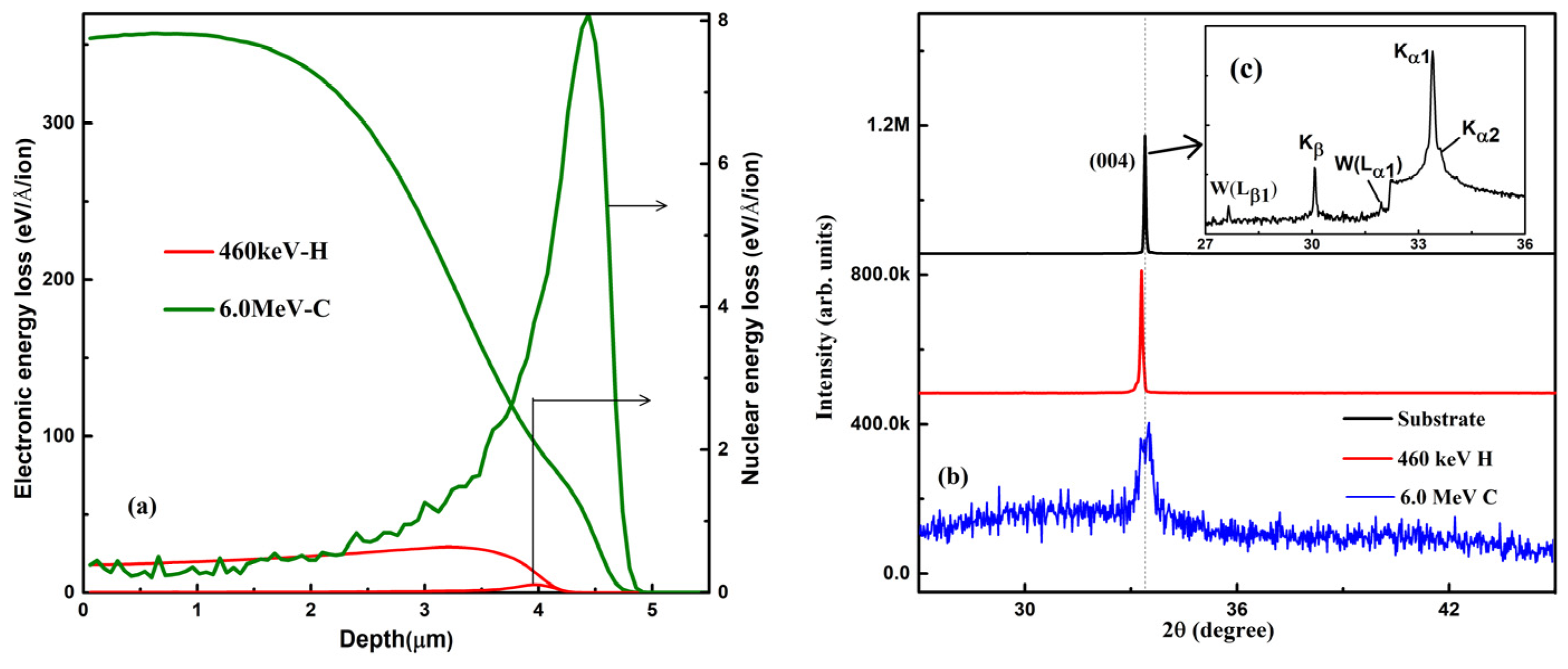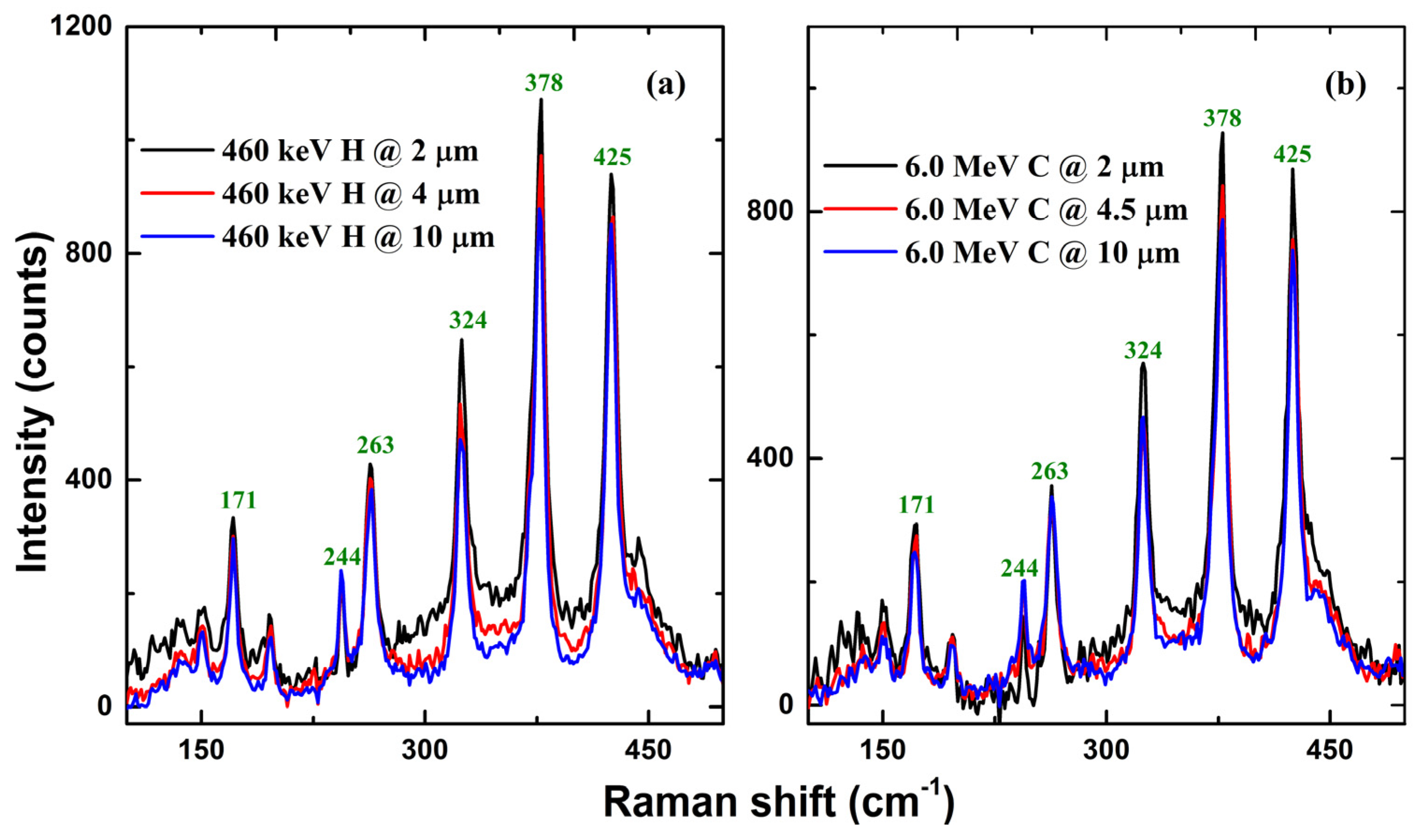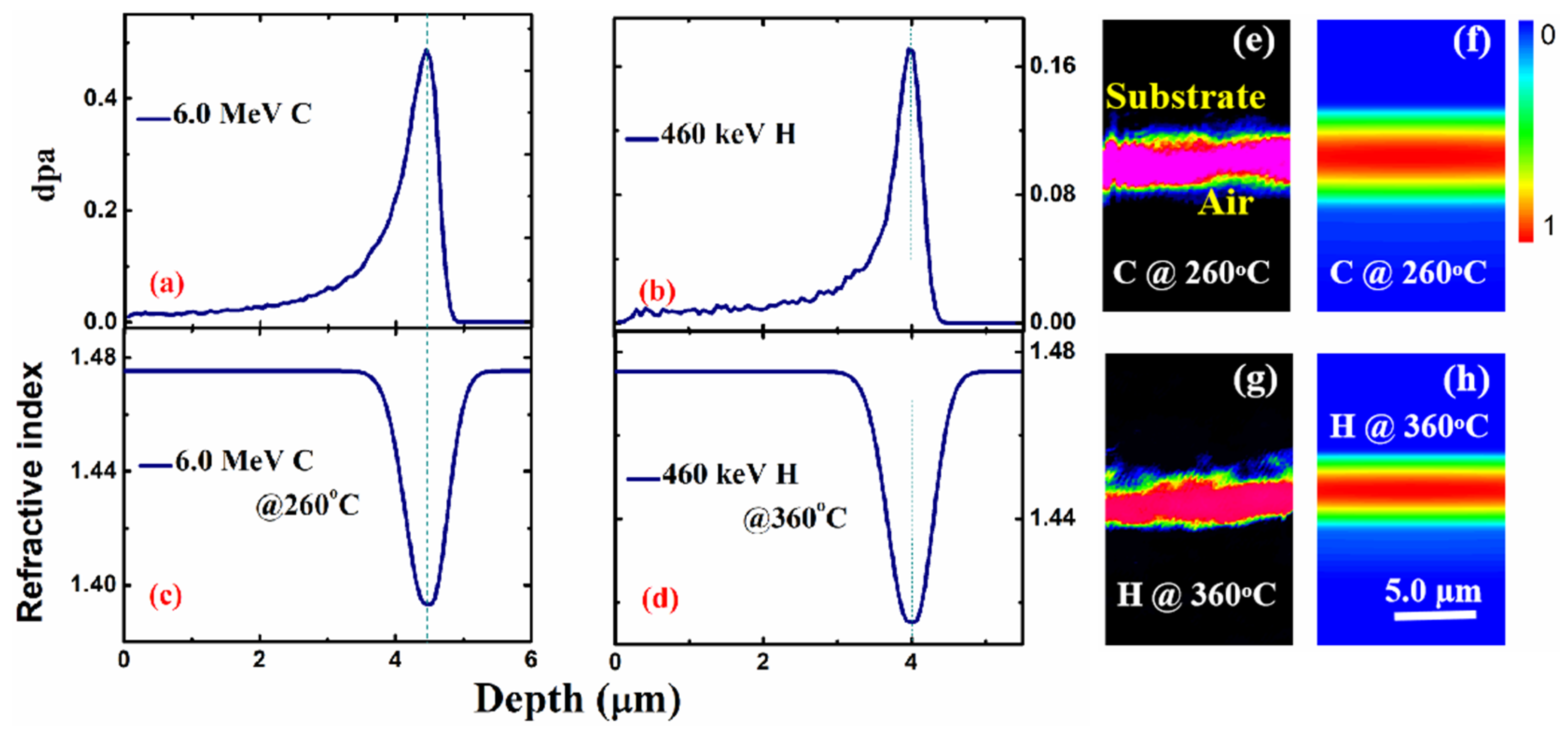Lattice Damage, Optical and Electrical Properties Induced by H and C Ions Implantation in Nd:YLF Crystals
Abstract
:1. Introduction
2. Materials and Methods
3. Results and Discussion
4. Conclusions
Author Contributions
Funding
Data Availability Statement
Conflicts of Interest
References
- Vieira, T.D.A.; Prado, F.M.; Wetter, N.U. Nd:YLF laser at 1053 nm diode side pumped at 863 nm with a near quantum-defect slope efficiency. Opt. Laser Technol. 2022, 149, 107818. [Google Scholar]
- Turri, G.; Webster, S.; Bass, M.; Toncelli, A. Temperature-Dependent Stimulated Emission Cross-Section in Nd3+:YLF Crystal. Materials 2021, 14, 431. [Google Scholar] [CrossRef]
- Fornasiero, L.; Kellner, T.; Kück, S.; Meyn, J.P.; Möbert, P.E.-A.; Huber, G. Excited state absorption and stimulated emission of Nd3+ in crystals III: LaSe3(BO3)4, CaWO4, and YLiF4. Appl. Phys. B 1999, 68, 62–72. [Google Scholar] [CrossRef]
- Xu, S.; Gao, S. A new wavelength laser at 1370 nm generated by Nd:YLF crystal. Mater. Lett. 2016, 183, 451–453. [Google Scholar] [CrossRef]
- Tu, Z.H.; Dai, S.B.; Zhu, S.Q.; Yin, H.; Li, Z.; Ji, E.C.; Chen, Z.Q. Efficient high-power orthogonally-polarized dual-wavelength Nd:YLF laser at 1314 and 1321 nm. Opt. Express 2019, 27, 32949–32957. [Google Scholar] [CrossRef]
- Sousa, E.C.; Camargo, F.A.; Raniere, I.M.; Baldochi, S.L.; Wetter, N.U. CW Operation of Diode Side Pumped Nd:YLF Laser. 2007. Available online: https://www.oasisbr.ibict.br/vufind/Record/IPEN_097d53b15b854cb516c687ee01d3bae1 (accessed on 7 December 2023).
- Turri, G.; Gennari, F.; Bass, M.; Toncelli, A. Mid-infrared spectroscopy of Nd:YLF crystal. J. Lumin. 2022, 246, 118842. [Google Scholar] [CrossRef]
- Zuo, Z.Y.; Dai, S.B.; Zhu, S.Q.; Yin, H.; Li, Z.; Chen, Z.Q. Power scaling of an actively Q-switched orthogonally polarized dual-wavelength Nd:YLF laser at 1047 and 1053 nm. Opt. Lett. 2018, 43, 4578–4581. [Google Scholar] [CrossRef] [PubMed]
- Liang, H.C.; Wu, C.S. Diode-pumped orthogonally polarized selfmode-locked Nd:YLF lasers subject to gain competition and thermal lensing effect. Opt. Express 2017, 25, 13697–13704. [Google Scholar] [CrossRef] [PubMed]
- Sedaghati, Z.; Nadimi, M.; Major, A. Efficient continuous-wave Nd:YLF laser in-band diode-pumped at 908nm and its thermal lensing. Laser Phys. Lett. 2019, 16, 125002. [Google Scholar] [CrossRef]
- Tang, Y.; Luo, Q.; Chen, Y.; Xu, K. All-silicon photoelectric biosensor on chip based on silicon nitride waveguide with low loss. Nanomaterials 2023, 13, 914. [Google Scholar] [CrossRef]
- Xu, X.; Yin, Y.; Sun, C.; Li, L.; Lin, H.; Tang, B.; Zhang, P.; Chen, C.; Zhang, D. Optical Temperature Sensor Based on Polysilicon Waveguides. Sensors 2022, 22, 9357. [Google Scholar] [CrossRef]
- Zhou, J.; Shao, Q.; Tang, C.; Qiao, F.; Lu, T.; Li, X.; Liu, X.; Zhao, H. Conformable and compact multiaxis tactile sensor for human and robotic grasping via anisotropic waveguides. Adv. Mater. Technol. 2022, 7, 2200595. [Google Scholar] [CrossRef]
- Rose, T.S.; Hopkins, M.S.; Fields, R.A. Characterization and control of gamma and proton radiation effects on the performance of Nd:YAG and Nd:YLF Lasers. IEEE J. Quantum Electron. 1995, 31, 9. [Google Scholar] [CrossRef]
- Dhoble, S.J.; Deshpande, S.P.; Pode, R.B.; Dhoble, N.S.; Gundurao, T.K. Radiation-induced defects in Pr3+-activated LiYF4 laser host. Radiat. Eff. Defect. Solids 2004, 159, 667–679. [Google Scholar] [CrossRef]
- Peakheart, D.W. Radiation-induced defects in lithium yttrium fluoride. Radiat. Eff. Defect. Soilds 1997, 143, 213–224. [Google Scholar] [CrossRef]
- Morato, S.P.; Macedo, T.C.A. F and photochromic centers in LiYF4: Nd crystals. Radiat. Eff. 1983, 72, 229–235. [Google Scholar] [CrossRef]
- Song, X.X.; Wang, Y.; Li, S.; Jia, C.L. The formation and characterization of optical waveguide in Nd:YLF crystal by 4.5-MeV Si ion implantation. Phys. B Condens. Matter 2019, 552, 209–213. [Google Scholar] [CrossRef]
- Lee, T.; Kim, J.; An, S.; Jeong, S.; Lee, D.; Jeong, D.; Lee, N.J.; Lee, K.; You, C.; Park, B.; et al. Field-free spin-orbit torque switching of GdCo ferrimagnet with broken lateral symmetry by He ion irradiation. Acta Mater. 2023, 246, 118705. [Google Scholar] [CrossRef]
- Wang, J.P.; Guo, L.; Luo, J.R.; Song, J.F.; Shi, Y.; Chen, C.A. In-situ TEM investigation of dislocation loop evolution in HR3 steel during Fe+ ion irradiation. J. Nucl. Mater. 2023, 578, 154309. [Google Scholar] [CrossRef]
- He, Z.; Theodosiou, A.; Cai, M.; Smith, A.; Jones, A.; Marsden, B.; Huang, H.; Zhou, X. Estimating the dimensional change behavior of nuclear graphite with heavy-ion irradiation-induced bending. Carbon 2023, 204, 357–366. [Google Scholar] [CrossRef]
- Daghbouj, N.; AlMotasem, A.T.; Vesely, J.; Li, B.S.; Sen, H.S.; Karlik, M.; Lorincík, J.; Ge, F.F.; Zhang, L.; Krsjak, V.; et al. Microstructure evolution of iron precipitates in (Fe, He)-irradiated 6H-SiC: A combined TEM and multiscale modeling. J. Nucl. Mater. 2023, 584, 154543. [Google Scholar] [CrossRef]
- Tan, Y.; Chen, F.; Wang, L.; Jiao, Y. Carbon ion-implanted optical waveguides in Nd:YLiF4 crystal: Refractive index profiles and thermal stability. Nucl. Instrum. Mater. B 2007, 260, 567–570. [Google Scholar] [CrossRef]
- Tan, Y.; Chen, F. Experimental observation and numerical simulation of guided modes in Nd: YLiF4 channel waveguides produced by carbon ion implantation. Phys. Status Solidi-R 2007, 1, 277–279. [Google Scholar] [CrossRef]
- Tan, Y.; Chen, F.; Wang, L.; Lu, Q.M. Optical planar waveguides in Nd: YLiF4 crystal fabricated by proton implantation. Phys. Status Solidi A 2007, 204, 3170–3173. [Google Scholar] [CrossRef]
- Ziegler, J.F.; Ziegler, M.D.; Biersack, J.P. SRIM-the stopping and range of ions in matter (2010). Nucl. Instrum. Mater. B 2010, 268, 1818–1823. [Google Scholar] [CrossRef]
- Ziegler, J.F. Interactions of Ions with Matter. Available online: www.srim.org (accessed on 7 December 2023).
- Li, Y.H.; Uberuaga, B.P.; Jiang, C.; Choudhury, S.; Valdez, J.A.; Patel, M.K.; Won, J.; Wang, Y.-Q.; Tang, M.; Safarik, D.J.; et al. Role of antisite disorder on preamorphization swelling in titanate pyrochlores. Phys. Rev. Lett. 2012, 108, 195504. [Google Scholar] [CrossRef] [PubMed]
- Xu, C.L.; Zhang, C.H.; Li, J.J.; Zhang, L.Q.; Yang, Y.T.; Song, Y.; Li, X.J.; Chen, K.Q. A HRXRD and nano-indentation study on Ne-implanted 6H-SiC. Nucl. Instrum. Mater. B 2012, 286, 129–133. [Google Scholar] [CrossRef]
- Costantini, J.M.; Kerbiriou, X.; Sauzay, M.; Thome, L. Ion-beam modifcations of mechanical and dimensional properties of silicon carbide. J. Phys. D Appl. Phys. 2012, 45, 465301. [Google Scholar] [CrossRef]
- Sommer, M.; Ebner, G.; Decho, H.; Hoja, S.; Fechte-Heinen, R. Surface preparation for characterization of nitride compound layers using hardness indentation and the Palmqvist method. J. Mater. Res. Technol. 2023, 24, 7974–7988. [Google Scholar] [CrossRef]
- Li, Z.M.; Zhang, L.M.; Jiang, W.L.; Pan, C.L.; Meng, X.; Chen, L. Hardness variation in nanocrystalline SiC irradiated with heavy ions. Ceram. Int. 2022, 48, 17846–17851. [Google Scholar] [CrossRef]
- Hu, S.W.; Li, T.J.; Su, Z.Q.; Liu, D.X. Research on suitable strength, elastic modulus and abrasion resistance of Ti–Zr–Nb medium entropy alloys (MEAs) for implant adaptation. Intermetallics 2022, 140, 107401. [Google Scholar] [CrossRef]
- Leide, A.J.; Lloyd, M.J.; Todd, R.I.; Armstrong, D.E.J. Raman spectroscopy of ion irradiated SiC: Chemical defects, strain, annealing, and oxidation. arXiv 2020, arXiv:2004.14335. [Google Scholar]
- Zhang, X.X.; Schulte, A.; Chai, B.H.T. Raman, spectroscopic evidence for isomorphous structure of GdLiF4 and YLiF4 laser crystals. Solid State Commun. 1994, 89, 181–184. [Google Scholar] [CrossRef]
- Hur, M.G.; Yang, W.S.; Suh, S.J.; Ivanov, M.A.; Kochurikhin, V.V.; Yoon, D.H. Optical properties of EFG grown Nd:YVO4 single crystals dependent on Nd concentration. J. Cryst. Growth 2002, 237–239, 745–748. [Google Scholar] [CrossRef]
- Cali, C.; Cornacchia, F.; Di Lieto, A.; Marchetti, F.; Tonelli, M. Nd: YVO4 crystalline film grown by pulsed laser deposition. Opt. Mater. 2009, 31, 1331–1333. [Google Scholar] [CrossRef]
- Zhang, H.J.; Meng, X.L.; Zhu, L.; Wang, C.Q.; Chow, Y.T.; Lu, M.K. Growth, spectra and influence of annealing effect on laser properties of Nd:YVO4 crystal. Opt. Mater. 2000, 14, 25–30. [Google Scholar] [CrossRef]
- Buissette, V.; Huignard, A.; Gacoin, T.; Boilot, J.P.; Aschehoug, P.; Viana, B. Luminescence properties of YVO4: Ln (Ln=Nd, Yb, and Yb-Er) nanoparticles. Surf. Sci. 2003, 532–535, 444–449. [Google Scholar] [CrossRef]








| Process | Annealing Condition |
|---|---|
| S0 | As implanted |
| S1 | S0 + 260 °C for 60 min |
| S2 | S1 + 310 °C for 60 min |
| S3 | S2 + 360 °C for 30 min |
Disclaimer/Publisher’s Note: The statements, opinions and data contained in all publications are solely those of the individual author(s) and contributor(s) and not of MDPI and/or the editor(s). MDPI and/or the editor(s) disclaim responsibility for any injury to people or property resulting from any ideas, methods, instructions or products referred to in the content. |
© 2024 by the authors. Licensee MDPI, Basel, Switzerland. This article is an open access article distributed under the terms and conditions of the Creative Commons Attribution (CC BY) license (https://creativecommons.org/licenses/by/4.0/).
Share and Cite
Qiao, M.; Wang, T.; Liu, Y.; Cui, W.; Wang, X.; Wang, Z.; Li, X.; Xu, S. Lattice Damage, Optical and Electrical Properties Induced by H and C Ions Implantation in Nd:YLF Crystals. Crystals 2024, 14, 146. https://doi.org/10.3390/cryst14020146
Qiao M, Wang T, Liu Y, Cui W, Wang X, Wang Z, Li X, Xu S. Lattice Damage, Optical and Electrical Properties Induced by H and C Ions Implantation in Nd:YLF Crystals. Crystals. 2024; 14(2):146. https://doi.org/10.3390/cryst14020146
Chicago/Turabian StyleQiao, Mei, Tiejun Wang, Yong Liu, Wanling Cui, Xiaoxin Wang, Zhenxing Wang, Xin Li, and Shicai Xu. 2024. "Lattice Damage, Optical and Electrical Properties Induced by H and C Ions Implantation in Nd:YLF Crystals" Crystals 14, no. 2: 146. https://doi.org/10.3390/cryst14020146
APA StyleQiao, M., Wang, T., Liu, Y., Cui, W., Wang, X., Wang, Z., Li, X., & Xu, S. (2024). Lattice Damage, Optical and Electrical Properties Induced by H and C Ions Implantation in Nd:YLF Crystals. Crystals, 14(2), 146. https://doi.org/10.3390/cryst14020146






